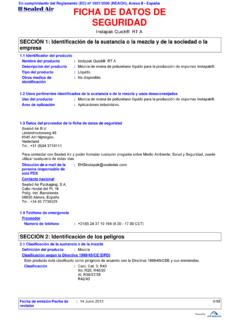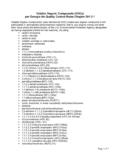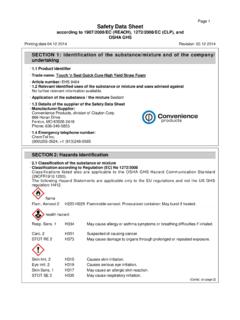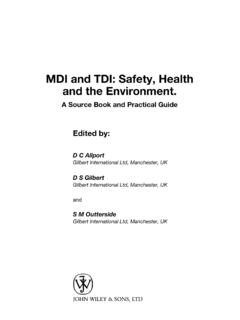Transcription of SAFETY DATA SHEET - sealedairprotects.com
1 Instapak Quick Tuff RT AProduct nameConforms to Regulation (EC) No. 1907/2006 (REACH), Annex II - United Kingdom (UK):Not means Product Details of the supplier of the SAFETY data type:e-mail address of personresponsible for this description:Liquid polyurethane resin mixture for the production of Instapak polyurethanepackaging Relevant identified uses of the substance or mixture and uses advised againstSECTION 1: Identification of the substance/mixture and of thecompany/undertakingNational Emergency telephone numberSupplierTelephone number:+31(0) 24 37 10 164 ( - CET)Sealed Air Limited,Telford Way, Kettering, Northants NN16 8UN England,Telephone: 01536 315700 Fax: 01536 410576 SAFETY DATA SHEETI nstapak Quick Tuff RT ASealed Air 456545 AH Nijmegen,NederlandTel.: +31 (0)24 3710111To contact Sealed Air with your Environmental, Health and SAFETY questions please either:Product use:Liquid polyurethane resin mixture for the production of Instapak polyurethanepackaging applications.
2 :Area of applicationClassificationCarc. Cat. 3; R40Xn; R20, R48/20Xi; R36/37/38R42/43::Human health hazardsLimited evidence of a carcinogenic effect. Harmful by inhalation. Harmful: danger ofserious damage to health by prolonged exposure through inhalation. Irritating to eyes,respiratory system and skin. May cause sensitisation by inhalation and skin Section 11 for more detailed information on health effects and 2: Hazards Classification of the substance or mixtureProduct definition:MixtureSee section 16 for the full text of the R-phrases declared aboveClassification according to Directive 1999/45/EC [DPD]The product is classified as dangerous according to Directive 1999/45/EC and its of issue/Date of revision :1/1314 June 2012 Instapak Quick Tuff RT AConforms to Regulation (EC) No. 1907/2006 (REACH), Annex II - United Kingdom (UK)SECTION 2: Hazards identification:Other hazards which do notresult in classificationPersons with a history of asthma, allergies or chronic or recurrent respiratory diseaseshould not be employed in any process in which this product is Label elementsSupplemental labelelements:Contains isocyanates.
3 See information supplied by the manufacturer. Thisinformation is provided by the present SAFETY Data symbol or symbols SAFETY phrasesS23- Do not breathe In case of contact with eyes, rinse immediately with plenty of water and seekmedical After contact with skin, wash immediately with plenty of soap and Wear suitable gloves and eye/face In case of insufficient ventilation, wear suitable respiratory In case of accident or if you feel unwell, seek medical advice immediately (showthe label where possible).R40- Limited evidence of a carcinogenic Harmful by Harmful: danger of serious damage to health by prolonged exposure Irritating to eyes, respiratory system and May cause sensitisation by inhalation and skin phrasesHazardous ingredients::::HarmfulPolymethylenepolyp henyl isocyanate4,4 -methylenediphenyl diisocyanateIndication of Other hazardsSubstance/mixtureMixtureOccupatio nal exposure limits, if available, are listed in Section 8.
4 :Identifiers67/548/EECP roduct/ingredientnameThere are no additional ingredients present which, within the current knowledge of the supplier and in the concentrationsapplicable, are classified as hazardous to health or the environment and hence require reporting in this 3: Composition/information on ingredientsDiphenylmethanediisocyanate,i somers andhomologuesCAS: 9016-87-975-90 Carc. Cat. 3; R40Xn; R20, R48/20Xi; R36/37/38R42/43[1] [2]4,4 -methylenediphenyldiisocyanateEC: 202-966-0 CAS: 101-68-8 Index: 615-005-00-935-50 Carc. Cat. 3; R40Xn; R20, R48/20Xi; R36/37/38R42/43[1] [2]See section 16 for the full text of the R-phrases declared above%TypeClassification[1] Substance classified with a health or environmental hazard[2] Substance with a workplace exposure limit[3] Substance meets the criteria for PBT according to Regulation (EC) No. 1907/2006, Annex XIII[4] Substance meets the criteria for vPvB according to Regulation (EC) No.
5 1907/2006, Annex XIIITypeDate of issue/Date of revision :2/1314 June 2012 Instapak Quick Tuff RT AConforms to Regulation (EC) No. 1907/2006 (REACH), Annex II - United Kingdom (UK)Wash out mouth with water. Remove dentures if any. Remove victim to fresh air andkeep at rest in a position comfortable for breathing. Do not induce vomiting unlessdirected to do so by medical personnel. If vomiting occurs, the head should be keptlow so that vomit does not enter the lungs. Get medical attention. Never giveanything by mouth to an unconscious person. If unconscious, place in recoveryposition and get medical attention immediately. Maintain an open airway. Loosentight clothing such as a collar, tie, belt or contactImmediately flush eyes with plenty of water, occasionally lifting the upper and lowereyelids. Check for and remove any contact lenses. Continue to rinse for at least 10minutes. Get medical contaminated skin with soap and water.
6 Remove contaminated clothing andshoes. Wash contaminated clothing thoroughly with water before removing it, or weargloves. Continue to rinse for at least 10 minutes. Get medical attention. In the eventof any complaints or symptoms, avoid further exposure. Wash clothing before shoes thoroughly before Description of first aid measuresRemove victim to fresh air and keep at rest in a position comfortable for breathing. Ifit is suspected that fumes are still present, the rescuer should wear an appropriatemask or self-contained breathing apparatus. If not breathing, if breathing is irregularor if respiratory arrest occurs, provide artificial respiration or oxygen by trainedpersonnel. It may be dangerous to the person providing aid to give mouth-to-mouthresuscitation. Get medical attention. If unconscious, place in recovery position andget medical attention immediately. Maintain an open airway. Loosen tight clothingsuch as a collar, tie, belt or waistband.
7 In case of inhalation of decompositionproducts in a fire, symptoms may be delayed. The exposed person may need to bekept under medical surveillance for 48 hours. In the event of any complaints orsymptoms, avoid further contact::::Protection of first-aiders:No action shall be taken involving any personal risk or without suitable 4: First aid Most important symptoms and effects, both acute and delayedPotential acute health effectsInhalation:This product is a respiratory irritant and potential respiratory sensitiser: repeatedinhalation of vapour or aerosol at levels above the occupational exposure limit couldcause respiratory sensitisation. Symptoms may include irritation to the eyes, nose,throat and lungs, possibly combined with dryness of the throat, tightness of chest anddifficulty in breathing. The onset of the respiratory symptoms may be delayed forseveral hours after exposure. A hyper-reactive response to even minimalconcentrations of MDI may develop in sensitised oral toxicity.
8 Ingestion may cause irritation of the gastrointestinal tract.:IngestionSkin contact:Irritating to skin. May cause sensitisation by skin contact. Animal studies have shownthat respiratory sensitisation can be induced by skin contact with known respiratorysensitisers including diisocyanates. These results emphasize the need for protectiveclothing including gloves to be worn at all times when handling these chemicals or inmaintenance to eyes.:Eye contactOver-exposure signs/symptomsSkin contactIngestionInhalationAdverse symptoms may include the following:respiratory tract irritationcoughingwheezing and breathing difficultiesasthmaNo specific symptoms may include the following:irritationredness:::Eye contact:Adverse symptoms may include the following:irritationwateringrednessDate of issue/Date of revision :3/1314 June 2012 Instapak Quick Tuff RT AConforms to Regulation (EC) No. 1907/2006 (REACH), Annex II - United Kingdom (UK)SECTION 4: First aid measuresNotes to physicianIn case of inhalation of decomposition products in a fire, symptoms may be exposed person may need to be kept under medical surveillance for 48 hours.
9 :Specific Indication of any immediate medical attention and special treatment neededNo specific treatment.:Promptly isolate the scene by removing all persons from the vicinity of the incident ifthere is a fire. No action shall be taken involving any personal risk or without combustionproductsHazards from thesubstance or mixtureDecomposition products may include the following materials:carbon oxidesoxides of nitrogenhydrogen cyanideIn a fire or if heated, a pressure increase will occur and the container may should wear appropriate protective equipment and self-containedbreathing apparatus (SCBA) with a full face-piece operated in positive pressuremode. Clothing for fire-fighters (including helmets, protective boots and gloves)conforming to European standard EN 469 will provide a basic level of protection forchemical protectiveequipment for fire-fightersIn case of fire, use water spray (fog), foam, dry chemical or Extinguishing media:::Do not allow water to enter container because a violent reaction may occur.
10 Do notuse water extinguishingmedia:Unsuitable extinguishingmedia:SECTION 5: Firefighting Special hazards arising from the substance or Advice for firefightersSpecial precautions for fire- EnvironmentalprecautionsAvoid dispersal of spilt material and runoff and contact with soil, waterways, drainsand sewers. Inform the relevant authorities if the product has caused environmentalpollution (sewers, waterways, soil or air).Stop leak if without risk. Move containers from spill area. Absorb with an inert materialand place in an appropriate waste disposal container. Dispose of via a licensed wastedisposal Methods and materials for containment and cleaning upSECTION 6: Accidental release Personal precautions, protective equipment and emergency proceduresFor non-emergencypersonnel:For emergency responders :No action shall be taken involving any personal risk or without suitable surrounding areas. Keep unnecessary and unprotected personnel fromentering.







